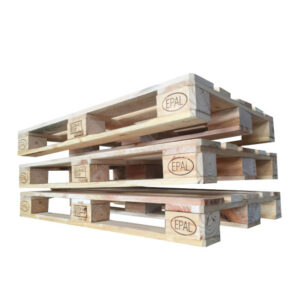EPAL Pallet Standards
EPAL Pallets: Standards, Specifications, and Sizes

EPAL Pallet Standards. EPAL pallets, also known as European Pallets, are the backbone of efficient logistics and transportation in Europe and beyond.
Manufactured according to strict EPAL standards, these pallets play a critical role in the supply chain by ensuring that goods are stored, transported, and handled safely and efficiently. This description provides in-depth insight into EPAL pallet specifications, dimensions, manufacturing requirements, and their significance in the global market.
What is an EPAL Pallet?
EPAL stands for the European Pallet Association, an organization that oversees the standardization and quality control of pallets used in Europe. The EPAL pallet meaning embodies a commitment to safety, efficiency, and sustainability.
EPAL pallets are produced using high-quality wood, and they undergo rigorous testing to comply with certain performance and safety standards.
In terms of dimensions, EPAL pallets adhere strictly to specific EPAL pallet sizes:
- Standard EPAL Pallet Size: 1200 mm x 800 mm (48 in x 32 in)
- Other common dimensions include 1100 mm x 1100 mm, used primarily in specific applications.
The difference between an EPAL pallet and a Euro pallet is essentially the same, as both conform to the same size and standard specifications.
These pallets often bear the trademark “EPAL” on their stringers, certifying their compliance with the EPAL standards.
EPAL Pallet Specifications
EPAL pallets adhere to well-defined pallet standards and specifications outlined in extensive documentation.
The key specifications include:
Material:
Typically made from high-quality wood or wood-based materials, EPAL pallets are designed to withstand weight and resist wear.
Weight Capacity:
The portata massima pallet EPAL (maximum load capacity) is approximately 1500 kg (3300 lbs) under dynamic conditions, ensuring durability during transport.
Treatment:
To meet ISPM 15 standards, EPAL pallets undergo heat treatment or other measures to ensure the absence of pests, making them suitable for international shipping.
Standard Grade:
EPAL pallets are categorized predominantly into Grade A (new or as new condition) and Grade B (minor signs of use). Each grade has specific quality marks to denote their condition.

EPAL Pallet Design Standards
The design standards for EPAL pallets are formulated to maximize both functionality and safety.
Key aspects include:
Decking Configuration:
The design features a symmetrical configuration, allowing freedom of handling from all four sides.
Reinforcements:
Timber reinforcements and screws are used to enhance the strength of the pallets.
Surface:
The top deck has smooth surfaces to prevent product damage and facilitate easy loading.
EPAL Pallet Dimensions and Standardization
As an established leader, EPAL has led the way in standardizing pallet dimensions, necessary for facilitating smooth logistics processes across Europe and globally.
European Pallet Size Chart:
The EPAL’s 1200 mm x 800 mm and the 1100 mm x 1100 mm dimensions ensure compatibility across various industries.
Standard Pallet Technical Drawings
Are available for manufacturers and users to understand the full design specifications relevant to EPAL pallets.
EPAL Pallet Manufacturing
EPAL pallet manufacturers worldwide, including those in India, follow strict compliance with the EPAL standards.
These manufacturers are licensed and are obliged to maintain the quality and standards set by the EPAL organization.
Comparison: EPAL vs. Euro Pallet
While both terms might be used interchangeably, it’s essential to note that all Euro pallets are technically EPAL pallets; however, not all Euro pallets meet the stringent quality standards enforced by EPAL.
The difference between pallet EUR and EPAL primarily lies in regulation and quality assurance.
Environmental Responsibility
EPAL is committed to sustainable practices. By promoting the reuse and repair of pallets, EPAL helps reduce waste and supports environmental stability. EPAL pallets are capable of being repaired and reused multiple times throughout their lifespan, which significantly lessens the impact on the environment compared to single-use alternatives.
Availability and Pricing
As the demand for EPAL pallets continues to grow, the market has seen an upsurge in the availability of these pallets for sale, as well as pricing strategies that vary based on condition and specifications.
Common inquiries include:
- Quanto costa un pallet EPAL? (How much does an EPAL pallet cost?)
- Pricing often ranges according to market conditions, quality grade (A or B), and size specifications. For specific pricing, it’s recommended to consult local EPAL suppliers.
Technical Documentation and Compliance
EPAL pallets come with comprehensive Technical Specifications available in PDF format.
This documentation includes critical information on standards and requirements that manufacturers must adhere to, facilitating compliance with EU regulations, as well as guidelines about import/export practices.
Conclusion
EPAL pallets are more than just logistical tools; they play a vital role in the global transport and supply chain system.
Understanding their specifications, standards, and significance can greatly aid businesses in optimizing their operations. By choosing EPAL pallets, companies ensure adherence to strict quality controls and bolster their commitment to sustainability.
For any business involved in logistics, warehousing, or distribution, investing in standard EPAL pallets guarantees a blend of efficiency, quality, and environmental responsibility.
Whether upgrading existing pallet systems or starting anew, the choice of EPAL pallets paves the way toward streamlined operations and successful supply chain management.
Showing the single result


